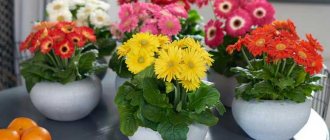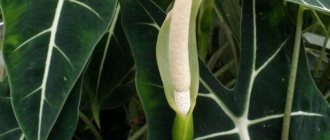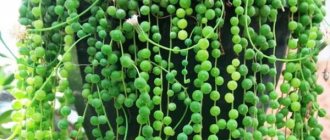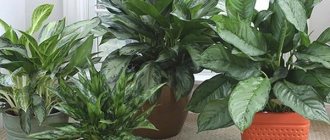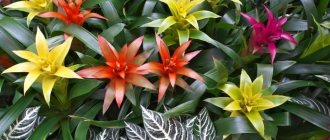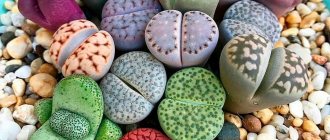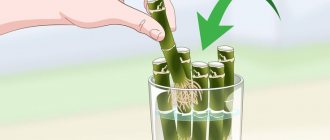Schefflera flower: instructions for home propagation
Schefflera is a beautiful indoor plant. In an artificial environment, it rarely produces buds. But flower growers love it for its gorgeous greenery, which has a rich natural hue and is often painted with white streaks. We learned to obtain planting material from this plant ourselves. Amateur chefs use different methods of flower propagation at home.
How to propagate Schefflera by layering
To propagate Schefflera by layering, the decorative indoor plant must be well developed and large enough. In the spring, the stem part of a decorative flower must be carefully cut with a clean and sharp instrument, and then wrapped in sphagnum moss, which is soaked in a nutrient solution. The top of the moss should be wrapped in plastic wrap to prevent it from drying out.
After about two months, a root system is formed in the cut, and after another couple of months, the stem part of the plant needs to be cut off below the area of the formed young roots. The resulting new plant is planted in a flower pot filled with a nutrient mixture. The parent plant needs to be cut off at the root and irrigation activities continued, which makes it possible to form new shoots. Thus, an amateur gardener can get two fully developed ornamental plants.
Propagation by cuttings
Cuttings are the most common way to obtain a new specimen of sheflera. For the success of the enterprise, it is necessary to correctly cut the adult plant. In appearance, it resembles an umbrella with a lush top and a thin bare leg. To obtain cuttings, use any part of the plant with 4-5 rosettes of leaves.
To obtain the required color of the seedling, look at the last tier of the original specimen. The pure greenery of the last rosette will be preserved in posterity. If a gardener wants to get a variegated plant, he must wait for the formation of a similar tier in an adult flower.
Cuttings are taken from a trunk that has not yet become woody. The old one has a solid structure. It is difficult to cut. It does not provide the required volume of the root system during germination.
The cutting process takes place in several stages.
- The chefs cut off the top from the mother specimen. It is rooted and subsequently planted as a separate plant.
- The “leg” is divided into several parts. The cuts are made with a sharp knife so that they are even and smooth. You cannot break or cut the plant.
Attention! When sliced, shefflera releases a lot of juice with an unusual aroma. It may be harmful to asthmatics. You should wear a mask and gloves when working.
- The sections are sprinkled with activated carbon, crushed into powder.
- Each cutting is dipped into a liquid with a root formation stimulator (for example, “Kornevin”) for 6-8 hours.
The process of root formation in sheflera cuttings at home occurs in soil or water. To place the “segments”, use transparent plastic cups with a volume of 0.5 liters.
- The lower leaves are removed from the cut top and 2-3 are left on top. While it is in the root stimulator solution, excess juice will drain and a film will form on the edge. However, before placing the cut in the ground, it is treated with a dry mixture of crushed coal and the preparation in which the cuttings stood after division. This is done using a cotton pad. They take the powder and rub it over the part that will be in the soil.
- A layer of fine expanded clay 1 - 1.5 cm is poured into the cups. Ready-made soil mixture for palm trees is added on top. It is loose, nutritious, suitable for all exotic plants, which include shefflera. The container is filled to 2/3 of its volume.
- Make a depression in the middle with a pencil or stick. The prepared crown is carefully inserted into it. Lightly press down the soil and water with a small amount of warm water.
- A plastic bag is placed on top. Using a thin elastic band, the bag is fixed along the edge of the glass. It should inflate like a balloon. The container with the future seedling is placed in a dark, warm place. Every day the bag is opened slightly to allow the indoor flower to breathe oxygen. As the soil dries, the plant is watered.
Attention! The creation of a greenhouse effect ensures conditions for the growth of sheflera in its natural environment.
At home, when propagating cheflera by cuttings, after 2-3 weeks you can notice by the color of the leaves that the plant has taken root and transplant it into a permanent pot.
Sheffler propagation options: cuttings, leaves and other examples
Schefflera is an ornamental plant with beautiful carved leaves. Found in the wild in Australia, China and the Pacific Islands. It is used for landscaping apartments, offices and restaurants. Among the species of cheflera, variegated varieties are often found.
Home care
Schefflera is quite easy to grow. She is unpretentious and undemanding in care. The following types of schefflera are mainly grown indoors:
- eight leaf;
- radiate;
- tree-like;
- palmate.
Schefflera in the house
In order for the plant to please its owners with its beauty, you should adhere to certain rules of maintenance and care.
Lighting
Sheflera prefers sunlight. But even in partial shade the flower feels good. The ideal place to grow this green beauty would be a well-lit place indoors.
You should place the flower on a windowsill that faces east, west or north. If the windows face south, then the plant should be shaded in the summer. If this is not done, burns may appear on the leaves. Northern windows are not suitable for variegated varieties; they need more light. In insufficient lighting, the pattern on the leaves will be less pronounced.
Additional Information! An adult plant can be placed near a window in the southern or eastern part of the room. If a flower is placed far from a light source, it will weaken and wither.
Humidity
Sheflera prefers high humidity indoors. At the same time, it adapts perfectly to normal humidity.
In winter, if the temperature exceeds 19 degrees Celsius and the air becomes dry, the flower begins to shed its leaves. Dry air affects the appearance of pests such as spider mites.
To make the chef happy with green foliage, you need to spray it twice a day with a spray bottle, this will give the leaves additional shine. It is recommended to wipe the leaves with a damp sponge once a week. It is advisable to place the decorative tree in places without drafts.
To increase humidity, you can place the flowerpot on a layer of wet pebbles
Temperature
For growing and propagating sheflera, a temperature of 15 to 20 degrees above zero is suitable. The plant does not like extreme heat.
High temperatures provoke yellowing and falling leaves. In the warm season, the flowerpot can be taken out into the fresh air or placed on the balcony.
Watering
Schefflera prefers moderately moist soil. Heavily moist soil can cause rotting of the root system. Drying out the soil also harms the flower.
In summer, the tree needs to be watered every three days. In winter - once every seven days. It is worth watering with settled, warm water. The water must stand for at least a day.
Additional Information! It is necessary to water the flower as soon as the soil has dried. The soil must remain moist at all times.
Fertilizer
Shafflera prefers only fertile soils. During the period of active growth, the plant is fertilized once every ten days.
Feeding is carried out in three stages:
- The first bait consists of nitrogen and phosphorus-potassium fertilizers, which are applied in early May. They contribute to the growth of green mass and are also important for the proper development of the rhizome.
- The second bait is introduced after a couple of weeks. Potassium and phosphorus are added to the soil.
- The third feeding is carried out in the fall. During this period, the laying of new leaves begins. The fertilizer consists of superphosphate and potassium salts, as well as organic fertilizers.
You can use homemade solutions for bait. The following can be used as fertilizer:
- Garlic water. Garlic is rich in vitamins, organic acids, sulfur and zinc. One clove of garlic should be squeezed through a press and diluted in one liter of water. The mixture is left for 45 minutes. Then used as root bait.
- Banana peels. First, the peels should be dried, then cut into small pieces and soaked in water for a couple of days. Strain the solution and pour the liquid under the root.
Once every two weeks, apply liquid fertilizer for indoor plants.
Trimming Features
Primrose propagation: basic methods and examples at home
Schefflera grows very quickly, so it needs regular pruning. If you do not do this, the plant will grow to the ceiling. This procedure not only gives the plant its shape, but also protects it from pests.
If pruning is done correctly, new branches will soon appear on the plant.
There are two types of pruning:
- crown formation;
- removing weak and yellow leaves.
For lush branching and a thick crown of the tree, it is necessary to cut off the top. It is advisable to prune in the spring, as soon as the plant wakes up after winter hibernation.
Trimming serves several functions:
- Gives the flower the desired shape.
- Has a beneficial effect on the growth of new branches and leaves.
- Serves as a source of planting material.
- Removes weak and diseased branches.
Important! When a bush loses all its leaves, it can be saved by low pruning.
Transplanting a plant
Begonia flower - propagation. Methods
A young plant needs to be replanted annually. An adult sheflera is transplanted every two years. A young bush is replanted by transferring the plant from one pot to another.
Important! When removing a plant, the first thing to do is inspect the root system. If signs of disease are detected, diseased roots are removed.
A layer of drainage is added to the bottom of the new pot. Carefully place the plant there and cover it with nutritious soil. For replanting, you should choose a slightly acidic (pH no higher than 6), light soil. Intensive watering completes the procedure.
When replanting a mature plant, it is carefully removed from the pot. Then the root system is cleared of the soil. The roots are carefully inspected for the presence of rot. When finished, the flower is planted in a new pot. It should be four centimeters larger than the previous one. A layer of expanded clay should be poured onto the bottom.
Important! If the plant can be easily removed from the pot, it means it needs replanting.
Reproduction methods
Beginners often worry about how to propagate sheflera at home. The flower is grown by seeds, air layering, and cuttings.
Schefflera: propagation by cuttings
Croton flower - propagation at home, what methods
One of the simplest methods. But it is necessary to cut the cuttings correctly. A branch with 4-5 rosettes of leaves is cut from an adult plant. Experienced gardeners advise taking cuttings in early spring.
To do this you will need a sharp knife or scalpel. Holding the tree by the trunk, the selected branch is carefully cut at an angle. The leaves are cut in half with scissors so that less moisture evaporates. You cannot break off the future sprout; you should cut it slowly.
How to propagate sheflera yourself? Cuttings occur in several stages:
- The top is cut off from the bush and placed in a container with water.
- After 12 days, roots appear on the plant.
- After the root system has appeared, the cutting can be divided and planted as a separate plant.
- Before planting, the flowerpot should be disinfected with a weak solution of manganese permanganate and dried.
- A drainage layer is poured onto the bottom of the container.
- The soil is poured up to half the height of the pot, so that the root does not extend beyond the edge of the pot. Ideally, 1.5-2 cm should not reach the edge.
- The cutting is placed in the middle and covered with soil. The top shoots will be open until the first shoots appear.
- At the end, the soil is moistened.
Important! Care should be taken to ensure that the sprout is not exposed to sunlight.
In a similar way, shefflera can be propagated by leaves. The probability of successful rooting is lower than with cuttings.
Schefflera flower - propagation by cuttings
How to propagate by seeds
The seed method is quite labor-intensive. This method is preferable in cases where it is not possible to get a cutting. Seeds should only be purchased in flower shops. Even if the seeds are of high quality, there is no guarantee that they will grow into seedlings.
Seeds are usually sown in February. By summer, the first shoots will grow and begin to actively develop in comfortable conditions.
Step-by-step instruction:
- The seeds should be soaked for 24 hours.
- Sow the seed in a wide container, two-thirds filled with soil.
- Place the seeds in shallow holes and sprinkle soil on top.
- Cover the container with seedlings with film.
- Ventilate and moisten once a day.
- After the first leaves appear, the shoots must be planted in separate containers.
For the first three months, it is necessary to maintain the air temperature within 18-20°C. Sheflera can be propagated by seeds if you follow the instructions.
Air taps
Growing flowers by layering is a very interesting method, which is used not only for indoor plants, but also for garden crops.
Reproduction by air diverters
How to root a sheflera using air layering? It is necessary to clean a small area on the trunk up to 5-7 centimeters high. Mash activated carbon in a container. Apply a thin layer to the cleaned area.
Wrap the treated trunk with film, tie a branch at the bottom with a rope, forming a small barrel. The trunk is loosely tied at the top, leaving a small hole.
Then the shoot is attached to a stick, which is placed in a pot next to the flower. Water the plant through the top hole. After 21 days, the first roots appear on the future bush. The film is carefully removed. The sprout must be cut at an angle and planted in a new place.
Additional Information! A frequently asked question when breeding is what does a Schefflera flower bring into the home? It is believed that the flower has magical properties that can strengthen and increase well-being.
Possible problems
When growing sheflera, gardeners may encounter some problems. Often, if grown and cared for improperly, the flower is attacked by pests:
- Spider mite. The plant is covered with a thin web. White-yellow blotches are visible on the leaf. To destroy the pest, the leaves are washed with soapy water, and then the preparations Actellik and Fitoverm are used.
- Greenhouse aphid. The insect is dangerous because it sucks the juice from the plant. The leaves turn orange, then curl and fall off. The drugs Actellik and Fufanon are used against aphids.
As a preventive measure, the leaves can be wiped with soapy water and the flower can be given a warm shower.
If planted and cared for incorrectly, the flower may encounter the following problems:
- Powdery mildew. The leaf blade is covered with a white powder-like coating. If you look closely, you can see small ulcers from which fluid is released. The leaves begin to wither, dry out and fall off. You can get rid of powdery mildew using systemic fungicides.
- Rust. This disease affects stems and leaves. A sign of the disease is clusters of orange or brown spores on the underside of the plate, yellow oval or round spots on the top. Then the spots turn into brown stripes and the leaves fall off. Eliminate the disease with chemicals: Topaz, Abiga-Pik, Baktofit.
- Gray rot. The main reason for the appearance is the presence of the flower in a cold, damp room. The disease can be detected by a gray coating on the leaf. Infected leaves are removed, and the plant itself is treated with chemicals such as Fundazol.
- Bacterial spotting. Watery, glassy spots appear on the undersides of the leaves and turn dark brown over time. It is impossible to cure the plant; it should be disposed of along with the soil, and the pot should be disinfected.
Falling leaves
It happens that the leaves turn yellow and the plant begins to shed its foliage en masse. Why do Schefflera leaves fall? This is often due to dry indoor air.
If a problem is detected, you need to check the soil in the pot, it should be moist. Drying out the soil slows down the growth of the leaf blade, it weakens and falls off. The fall of variegated foliage can be caused by a lack of light. Too wet soil can also cause leaf shedding.
Blackening of leaves
When the root rots, the leaves of the flower begin to turn black. This happens when you water too often.
Black leaves on Schefflera
The flower is removed from the pot and the damaged roots are carefully removed. Afterwards they need to be sprinkled with crushed coal and dried.
Important! If the bush is exposed to a draft for a long time, it can catch a cold. The leaves turn black and fall off. The leaf blade becomes covered with spots after exposure to sunlight. Yellow leaves indicate the presence of pests.
If you adhere to the rules of care and planting, you can easily grow sheflera at home. It is believed that even a novice lover of indoor flowers can cope with this.
Source: https://greensotka.ru/dekorativno-listvennye/shefflera-razmnozhenie.html
Leaf propagation
Schefflera is also easily propagated using leaves. Any leaf with a petiole is plucked off from an adult plant. It is placed in a glass of water in which the root former is diluted. The container is covered with polyethylene on top and placed in a warm place protected from the sun, creating a greenhouse effect.
Sometimes a glass jar, plastic bottle or factory dome is used instead of a bag. The store-bought item has a lid on top, through which it is convenient to ventilate the plant. Every day for 15-20 minutes, the glass with the leaf is opened to ventilate the future seedling and allow it to breathe air.
Germination of the sheflera leaf should take place at a temperature of at least 23 degrees. If all conditions are provided, the first roots will appear in 15-20 days.
Attention! Sometimes the petiole begins to rot. You need to open the glass, change the water and cut the leaf to a healthy part. Reproduction of sheflera by leaf is shown in a special photo.
Propagation by seeds
The variegated houseplant does not bloom. Then how to propagate sheflera from seeds? Answer: buy planting material in the store. In its natural environment, it decorates itself with flowers in which a seed is formed. Before planting, it is soaked in a nutrient solution.
- To sow seeds, take deep boxes.
- The bottom is covered with any drainage material.
- Soil is poured on top 20-30 cm.
- At a distance of 15 cm from each other, holes with a depth of 10-15 cm are made with a pencil. The seeds are lowered into them.
- Boxes with seedlings are covered with polyethylene (glass) and placed in a warm, shaded place.
- Periodically carry out simple maintenance: open the film, water the soil. When seedlings appear, spraying is carried out. After the formation of 2-3 leaves, they are planted in pots.
Reproduction and care of Schefflera at home
Like many green crops, Schefflera is propagated in two ways: vegetative and generative . The vegetative method includes propagation by leaves, cuttings, air layering, and the generative method by seeds.
The flower provides a significant choice of propagation methods
The required air temperature for reproduction is +20 - +23 degrees, so it is better to carry out this procedure in the spring. But for subsequent life activity, the optimal temperature for the crop in summer is 16 - 22 degrees, and in winter 16 -18 degrees. Schefflera is difficult to tolerate high temperatures.
How to propagate by cuttings
For propagation in the house, it is necessary to select healthy and mechanically undamaged cuttings up to 10 cm long. The quality of the cuttings is determined by their appearance.
Soil preparation is carried out as follows:
- Select the appropriate container for the cuttings , this can be a small pot or a plastic glass. You should not immediately plant the cuttings in a large container, since at the initial stage of growth the plant requires abundant watering, and it is more convenient to do it in a small container.
- 3–4 cm of drainage is poured onto the bottom of the container. It saves the plant from excess moisture.
- Add turf soil with sand and humus in the following ratio:
| Turf | 2 parts (66%) | or | Turf | 2 parts (66%) |
| Sand | 1 part (33%) | Humus | 1 part (33%) |
You can also use compressor soil, peat, greenhouse soil (for replanting). The soil must be saturated with nutrients.
The above three points concern the soil, both for planting cuttings and for growing the entire plant. The only difference is in the volume of the container; a full-fledged plant requires a large container where the roots will receive sufficient nutrition and space.
After planting the cuttings, the container is placed on the windowsill, where there should be good consecration . For cuttings it is necessary to create a greenhouse effect; for this they use plastic, glass jars, and special devices that can be purchased at gardening stores.
The time increases gradually from 10 minutes to daylight . It is advisable to spray the cuttings with a spray bottle and moisten the soil as it dries.
Propagation by cuttings is found everywhere. For example, we talked about the procedure for such reproduction when growing pelargonium.
From seeds
Schefflera seeds are purchased in stores, since it is very difficult to obtain seeds on your own in the climatic conditions of Russia .
Propagation by seeds is not easy. It is better to sow seeds in winter in February, then by spring the plant will grow and receive all the necessary conditions for development, light and temperature.
Before sowing the seeds, they are soaked for a day in a solution of water and epin, or in warm water. Then they select a container, preferably deep and wide, for example, a box. Soil is added to it and 15 cm holes are prepared, then the seedlings are planted in the holes and sprinkled with soil on top.
For seeds , as well as for cuttings, a greenhouse is needed , so the box is covered with film. Procedures are carried out for regular ventilation, moistening the substrate, and wetting the sprouted seeds according to the above-established deadlines.
It’s great if the box with the sown seeds is placed in a place where it will be heated from below, this will speed up germination and growth. If you decide to place a container with seedlings on the windowsill, pay special attention to the temperature ; in winter it can be much lower than optimal.
Growing from seeds is not an easy process and requires experience and correct procedure from the grower. So, we revealed all the nuances of growing thunbergia from seeds.
How can it reproduce by leaf?
Propagating Schefflera by leaf is not the easiest way, since the leaf does not always produce roots.
Let's look at the stages of propagation by leaf :
- We select a medium-sized leaf and carefully tear it off from the main plant. It is important that the growth zone (the growth between the base of the leaf and the stem of the plant) separates along with the leaf.
- Next, prepare a stimulating solution (by analogy with cuttings) and drop the required number of leaves into it; it is better if there are more than two of them, since not all of them will be able to take root; a small supply is needed. Set aside the water for the solution.
The stimulating solution requires the correct dosage and settled water
- Place the prepared dishes with the solution and leaves in a warm place, cover with film and glass.
- When the leaves form roots, they need to be planted in the soil, creating a greenhouse. There is no need to ventilate at first; the leaf must get used to the conditions. It is worth monitoring soil moisture.
After the operations, when Sheflera grows up, she is transplanted. Leaf propagation is not common. However, we talked about the correct propagation of violets by leaf at home.
Air layering
An adult plant can reproduce by layering. The process is best carried out in the spring. We make a cut on the stem (the stem is not the main one!) and wrap this place with moss and cotton wool, then apply a film.
Cotton wool and moss must be constantly moistened by the grower. After which, after 1.5 months, the roots begin to grow. Air layering is separated along with the stem, carefully without damaging the mother plant.
Not all plants can reproduce this way.
However, we considered the procedure for propagating bougainvillea by air layering.
How to propagate Schefflera - by cuttings, leaves, seeds, air layering, stages and technology
Reproduction of Sheflera is a simple matter, carried out using two methods. If everything is done correctly, entire thickets will appear on the windowsill. We'll talk about how to propagate Schefflera further.
Schefflera propagation technology
To propagate the plant, the following conditions must be met:
- Create a temperature of 200 Celsius. In winter, 120 is enough. When growing, you need to take into account that the plant loves light, cold and drafts will not bring a positive result. The flower needs to be placed closer to the light.
- During cultivation, the variegated color should not be allowed to become pale.
This indicates that there is not enough sunlight, and the flower needs to be placed on the illuminated side. Otherwise, the crop will begin to wither and shed its leaves. But if it is very hot in summer, then burns may appear on the leaves. How does Schefflera reproduce at home? - Excessive watering should be avoided. If the soil is moist, then there is no need to water, but the soil should not be dry either. In order for the flower to continue to grow, you can place it in warm water for about a quarter of an hour.
- Dry fertilizers are not used. Liquid fertilizers are used to nourish the plant. Once every two weeks in the summer and once every two months in the winter. Spraying the flowerpot is required from a spray bottle, but with water at room temperature. If other crops grow along with the flower, then there is no need to spray it. Other seedlings will release large amounts of moisture.
- The flower is replanted for the first time after its propagation, and then as needed. To get your bearings, you need to take out the flower with soil and examine the root. If the roots are thick enough in the soil, then replanting is necessary. To do this, the culture from one container is transferred to a larger container.
- Schefflera is replanted without soil. To do this, expanded clay is poured into the bottom of the pot, and earth is sprinkled on top.
Propagation by cuttings
We will tell you step by step how to root Schefflera using cuttings below. This method is the most optimal. Flower lovers use cuttings with strong roots, pruned in the spring. You can cut it using a knife or scalpel. You need to hold the trunk carefully, holding the plant, making sure it doesn’t break.
Reproduction process:
- The flower grower must wear special gloves and a mask. These are safety measures when a person has increased sensitivity to odors.
- Cuttings that have developed and become stronger are ideal for propagation.
- It is recommended to leave the cuttings in the drug solution overnight. This is heteroauxin.
- Processing of cuts is necessary to stimulate root formation. To do this, crushed activated carbon is used.
- In total, there are two types of rooting. One of them using water, and the second using a substrate. It will take about a month for roots to form in water. If the plant is variegated, then you need to plant the crop in the ground later, water the soil, and cover the shank with a bag. Make holes in the bag for ventilation. Every day you need to remove the bag for about half an hour, as the plant must receive oxygen.
- Substrates can be sand or soil. Be sure to use large grains. The bag must be placed on the plant immediately, and everything else is done as with water.
- Material for drainage is placed at the bottom of the container. Soil is placed in the pot, but three centimeters remain from the top wall.
- The prepared cuttings are planted. After the procedure, the flower is placed on the windowsill. Do not forget that the temperature when planting should be about 23 degrees.
- Ventilation of the plant is carried out regularly, increasing the frequency and duration.
Leaf propagation
Schefflera - leaf propagation
The plant is easily propagated by leaves. The leaf on which the petiole is located is plucked off from the crop. Place it in water previously diluted with a root former.
List of replanting activities:
- Polyethylene is placed on the container. Instead of a package, you can use a purchase coupon, a plastic bottle or glassware.
- The pot should be placed in a warm place, but it should not be exposed to direct sunlight. This creates the greenhouse effect.
- Every day the plant is opened for about a quarter of an hour. This way the crop will receive oxygen, and the seedling will be periodically ventilated.
- During germination of Schefflera, you need to ensure that the temperature is about 23 degrees.
- After about 20 days, roots will appear.
In some cases, the petiole rots. To prevent this from happening, you should raise the glass, change the water and cut off the leaf, getting to a healthy place.
Propagation by seeds
The process of propagation by seeds takes a long time. You cannot choose seeds yourself, you can only purchase them. It is ideal to plant in winter, but it is best to plant at the end of March.
The soil must first be loosened and moistened. This will ensure access to oxygen. To avoid mistakes with land, it is recommended to use purchased land. If gardeners are experienced, then you can make a mixture of sand and peat.
Before planting, the seeds are kept in zircon. This substance must be diluted with water.
Planting process:
- The seed is planted approximately half a centimeter deep.
- The earth is watered.
- The pot is placed in a warm place, and the temperature drops. The indicator is 15 degrees.
- If it is very hot, then the flower is sprayed with a spray bottle.
Reproduction by air layering
The plant can be propagated by air layering. This is best done in the spring.
What should be done:
- Make a cut on the stem. No need to use the main stem. The incision site should be wrapped in moss or cotton wool, and then a film should be applied.
- They moisturize the moss.
- After about a month, roots appear.
- The cuttings are separated with care, without damaging the mother plant.
The flower is placed in a substrate enriched with minerals.
How to propagate Schefflera, advice from gardeners
How to propagate Schefflera at home?
In order to properly propagate Schefflera and the plant continues to grow to please the eye, you can use the following tips:
- Maintain temperature during germination. 20 degrees is enough, and in winter 12.
- There is no need to create drafts and cold.
- Place the flower on the bright side of the apartment.
- If there is not enough sunlight, the bright color will begin to turn green. In this case, the pot must be moved to another place so that leaves do not fall into the crops.
- Avoid exposing the plant to direct sunlight, otherwise burns will appear on the leaves.
- Do not water too much, as the roots may rot. If the soil is wet, you should no longer water.
- Do not feed the plant with dry products. Using liquid fertilizers is an excellent solution to the problem.
- It is recommended to place other crops next to the flower, so the humidity will be maintained.
- Inspect the roots; if the roots have grown, they should be divided.
Types of culture
In total there are about 200 varieties of the plant. But this is in the wild. The following are grown indoors:
- Eight-leaved Schefflera. This is the most widespread culture. This is a bush with leaves spread out like fingers in different directions. The shape resembles a lanceolate, with light-colored veins. Plant up to half a meter high. Variegated leaves are also found on the crop. When several seedlings are planted in one container, together they form a hat.
- Tree-like. In appearance it resembles a tree with a trunk and spotted green leaves. For this variety, it is better to have a support with which to support the trunk.
- Radifolia. During growth it resembles the shape of a tree. There are 7 leaves on it. The color is mostly green.
- Business. The plant is about 40 cm high. The shape of the leaf resembles an oak tree, and the leaf itself is large. The color is green and spotted.
How to prepare the soil
To transplant a plant, you need to properly prepare the soil. To do this, do:
- Take turf, humus and sand. 2 parts one and one.
- Expanded clay is poured onto the bottom of the pot about 10 cm.
- Place a container of earth on the battery.
- The temperature of water and land should be the same.
The soil for planting has been prepared and can now be used. The soil should be soft and loose.
About flowering
The plant does not bloom indoors. The flowering process is associated with temperature and humidity conditions, and this is not easy to create in an apartment.
When flowering occurs, the flowers are yellow and the inflorescences are paniculate. Flowers appear in the summer.
About cultural diseases
If the plant is not properly cared for, it will develop diseases and pests. List of negative consequences:
- If you water the plant frequently, the leaves will turn yellow and fall off.
- If the soil is dry, the plant will soon wither and the plant will begin to shed its leaves.
- Affected soil and improper watering will lead to the appearance of mites and aphids.
If the disease is the result of a lack or excess of moisture, then watering the plant should be normalized and the pot should be placed in a bright place. The original form will be assumed as time passes.
If pests appear on the crop, then it is necessary to treat it with an insecticide composition. Isolate Schefflera in a bag for several days. Repeat treatment if necessary. The plant must be isolated from all other crops.
About ancient signs according to Shefler
The plant contains toxic substances, but it normalizes the space in the house. The flower absorbs negative energy, thus clearing the living space of negative emotions.
If the culture is in the bedroom, then the flow of energy is normalized. When a plant sheds its leaves, the atmosphere inside the house is negative. If Sheflera begins to grow rapidly, then replenishment is expected soon.
The crop is often grown in offices. It has a strict and neat appearance, unpretentious in care. It is possible that it attracts money and luck, good people and experienced employees.
Scheffler is often told on the school table that new material was better absorbed, and the student could easily gain knowledge. Harmony between married couples and the development of normal business relationships are achieved thanks to this plant.
In this video you will learn how to propagate Schefflera:
Select it and press Ctrl+Enter to let us know.
Houseplants
Source: https://PlodOgorod.com/cvety/komnatnye-rasteniya/kak-razmnozhit-shefleru.html
Correct transplantation of Schefflera
Schefflera grows quite quickly, it can grow by 30 cm per year, so it requires frequent replanting. But if you replant it at 2 - 3 years, nothing bad will happen, Schefflera will simply grow more slowly.
When it is clear that the plant is becoming crowded , then you should prepare a larger container for it. Let it be very large, this culture loves freedom. It is worth drilling holes in the container so that excess water does not cause harm.
Transplantation is carried out in autumn or spring. The soil is prepared in a known way - drainage, soil mixture, the loan is evenly distributed throughout the container.
Indication for transplantation: cramped pot
| Stage 1 | Preparing containers |
| Stage 2 | Carefully remove the plant from its pot along with the soil, it is important not to damage the roots and stems |
| Stage 3 | Planting in a container that already has drainage and some soil. After the plant is transferred, the remaining space is filled with substrate |
| Stage 4 | Abundant watering |
That's all, no special care is required after transplantation. Everything is carried out in standard mode.
The propagation of Schefflera largely depends on the attention of the grower , on maintaining suitable temperature and water conditions, and on correctly selected soil. If you follow all these recommendations and technologies, you can get beautiful plants that will delight your household with their beauty and uniqueness.
Transplanting a plant
Sheflera grows quickly and increases by 0.3 m every year. Therefore, it is recommended to replant it. But it needs to be moved to new containers every two years, but not more often.
At this time, the flowers will slow down. For normal formation, the plant needs a lot of space, and replanting is necessary in large pots. This procedure is carried out in spring or autumn.
Sequence of work:
- Expanded clay or other drainage is placed at the bottom. This is necessary so that excess moisture is absorbed.
- The soil is distributed over the pot and covered evenly.
- The plant is removed through a pot along with the soil and transferred to another pot.
- Sprinkle the soil, then compact the layer of soil.
- Water the ground well.
There is no need to carefully care for the plant, ordinary actions are enough:
- Watering should be done once every two days. It's enough.
- Maintain the temperature from 20 to 24 0C.
- Apply organic fertilizers containing nitrogen and potassium.
The plant is easy to grow, even if you are a beginner gardener. The bush can be grown, watered, replanted, fertilized and gain invaluable experience.
Proper propagation of sheflera at home
Schefflera is a wonderful southern flower, which in our cool climate is usually grown as an indoor flower. The flower looks great in the interior, is able to maintain an optimal microclimate in the room, purifies the air and simply decorates the space. Let's find out how the cheflera reproduces at home and what methods are the most effective.
Cuttings
Vegetative propagation is the best option for cheflera at home. It is necessary to select only undamaged, strong and completely healthy shoots for rooting. The length of the cutting should be around 10 cm. It should have at least 5 leaves: cut off the lower ones, and leave the top 2-3.
The cutting should be taken half lignified: hard at the base and flexible at the end. The shoot needs to be cut, not broken off: an accurate and even cut will increase the chances of successful root regrowth. While breaking off only injures the mother plant, reducing the likelihood of rooting of the cuttings. Sprinkle the slices with crushed coal.
Rooting procedure
- The cuttings are soaked in a root stimulant solution. The procedure will help plants take root faster and should last 7-10 hours for optimal effect.
- While the cuttings are being treated with a stimulant, you need to prepare the soil and container for planting. You can use small pots or plastic glasses as containers. You should not root the plant in a container that is too large, as it will be more difficult to saturate its roots with water.
- A layer of drainage is poured onto the bottom, which will protect the roots of the cutting from waterlogging. A layer of substrate consisting of turf, humus and sand is laid out on the drainage. It is important that the soil is sufficiently loose and fertile.
- The planting material should be rooted in the prepared substrate, and then the container with the cuttings should be placed on a light windowsill. A plastic bag is placed on top of the container to create a greenhouse effect that promotes faster rooting.
- The cuttings then need to be ventilated daily by lifting the plastic cover. If the room is cool, place the container on a warm stand: for example, on a wooden plank placed on a radiator.
- When the young cheflera has 3-4 true leaves, the cover is removed for the whole day and put on only at night. The cuttings need to be sprayed periodically, moistening the soil as its top layer dries. When the seedlings grow up, they can be placed in permanent pots.
Attention: you can root the cuttings in water.
Transplantation with cuttings and seeds
Propagation by cuttings is the easiest option for gardeners. Flower growers use semi-lignified elements cut in the spring. The stalk is cut with a knife or scalpel. To do this, you need to hold the barrel and carefully deepen the blade, but under no circumstances break off the barrel. At the same time, you should not saw it too actively.
So, how does a plant reproduce in stages? The florist should work with gloves and a protective mask if a person is prone to allergies or suffers from asthma, since sheflera has a pronounced, pungent odor. For propagation at home, it is better to select well-developed cuttings, and before planting in the ground, keep the sprouts in a heteroauxin solution overnight. Cuts should be treated with a root formation stimulator or crushed activated carbon. This way, it will be easier to cope with further planting.
There are 2 methods of rooting: using water or substrate. To root sheflera in water, after about a month (for variegated varieties this needs to be done later), plant the cuttings in the ground and cover them with a bag, having previously made holes in it for ventilation (can be replaced with a glass jar). Every day you need to remove the bag for half an hour so that the plant has access to fresh air.
Substrates may be different. The most common are soil and sand (necessarily coarse-grained). With this method, the bag is put on immediately, but otherwise the rooting procedure is the same as in the case of water.
Additionally, drainage material (pieces of brick) is added to the bottom of the pot. The container is filled, leaving a few centimeters to the top, and the cuttings are planted in the ground. After this procedure, the seedling is placed on a well-lit windowsill, trying to maintain an optimal temperature of up to 23º C. Sometimes it will be necessary to ventilate the plant, gradually increasing the time and frequency.
A longer process is planting sheflera using seeds, which can only be purchased, since it is impossible to obtain them yourself. It is optimal to plant them at home in winter; in extreme cases, this should be done before the end of March. The soil should be loose and allow the plant access to oxygen and moisture. For beginners, it is good to use ready-made purchased soil, and for more experienced gardeners, peat and sand. Before planting, the seeds are kept in a zircon solution.
Seeds
A much more troublesome and lengthy procedure than the previous one. That is why seed propagation is chosen only if there is no way to get a Schefflera cuttings. We recommend purchasing seeds in the store, since it is almost impossible to obtain them yourself. Even if seeds are obtained, there is no guarantee that they will sprout.
It is best to plant seeds in February: so that by spring-summer the seedlings have already grown and can develop normally in conditions of long daylight hours and warmth.
Procedure
- Before planting, the seeds are soaked either simply in warm water for a day, or in a weak solution of the stimulant Epin, Heteroauxin.
- Sowing is done in a wide and fairly deep container, two-thirds filled with substrate.
- The seeds should be placed in shallow holes and sprinkled with a little soil on top.
- A film is placed on the container for a greenhouse effect. Plantings should be ventilated regularly and the soil should be moistened if necessary.
- When the first full leaves appear on the seedlings, the sprouts are planted in separate pots.
Schefflera diseases
Many people wonder what to do if the leaves of the sheflera fall off? The plant, despite its unpretentiousness, reacts negatively to high and low temperatures, sudden temperature changes, waterlogging and drafts, and lack of light. The reaction to many external stimuli in a tropical flower is the same - the shefflera sheds its leaves. Therefore, it is necessary to carefully analyze the conditions of detention in order to determine and eliminate the cause of leaf fall. When conditions improve, the plant stops shedding leaves, and over time its decorative appearance will be restored.
It is more difficult to cope with root rot, which occurs with frequent waterlogging and keeping at low temperatures. Rot is manifested not only by the withering and falling of leaves, but also by the appearance of black spots on them. If such symptoms of the disease occur, remove the plant from the pot and check the condition of the roots. Damaged, diseased roots are removed. Then the root system is immersed in a weak solution of potassium permanganate for twenty minutes to disinfect, and then planted in a new pot and new soil. The old pot must be disinfected before reuse.
- Excessive watering can be manifested by the appearance of small bubbles on the underside of the leaf blade. This disease is called "dropsy".
- Direct sunlight can cause yellow spots to appear on the leaves. With a lack of light, the leaves turn pale, especially variegated varieties lose their decorative effect.
- The tips of the leaves turn brown and dry out if there is insufficient watering or low ambient humidity.
Leaf propagation
This is also not the easiest method of propagation and is used if it is impossible to get a cutting. Unfortunately, the leaf is not always able to release roots, so the procedure often ends in failure.
Procedure
- You need to select a medium-sized leaf, then carefully separate it. Make sure that the so-called growth zone, the thickening at the bottom of the leaf, separates from the leaf.
- Soak the leaf (its lower part) in the stimulant solution. It is better if you soak several specimens at once to increase the likelihood of survival.
- The container with water and the leaf should be covered with film and placed in a bright, warm place for roots to grow.
- After small roots appear at the bottom of the leaves, you can plant them in pots with substrate. Here, too, you need to form a mini-greenhouse so that the leaves take root faster.
By layering
This propagation method is usually used for large varieties of sheflera. The method gives good results, however, it requires experience, skill and accuracy from the grower.
Procedure
- In the spring, cheflers make an incision on the shoot closer to the base, then covering it with damp sphagnum.
- The incision is secured with adhesive tape, tape, or other flexible fastener. It is recommended to wrap the moss with film on top to create warm and humid greenhouse conditions inside.
- Moisten the moss regularly, preventing it from drying out. After a month, if all conditions are met, roots will appear on the cut.
- The shoot is then cut off slightly below the formed roots and transplanted into a nutrient substrate. Watch a video about rooting sheflera by layering.
Let's find out how to care for a young sheflera so that it grows and develops well.
Lighting
It is better not to place this flower in tight, shaded corners of the house. For good growth and development, sheflera needs open sunny space. High-quality lighting is especially important for flowers of variegated varieties: in the shade, bright leaves lose their decorative effect and become ordinary monochromatic.
It would be ideal to place the pot on an eastern or western windowsill. On a southern windowsill, it is necessary to provide shade for the plant from the scorching midday sun. Otherwise, whitish burn spots will soon appear on the beautiful foliage of the shefflera.
Air humidity
Do not keep a pot of shefflera near working heating radiators. Such proximity negatively affects the condition and decorativeness of the flower: the plant needs quite high air humidity.
Temperature
Schefflera reproduces best at +20-23 degrees. However, after rooting, the plant needs a lower temperature: +16-22 degrees in summer and +16-18 in winter. Too high temperatures are absolutely not suitable for this flower: the cheflera tolerates the heat with great difficulty.
Priming
Sheflera requires soil of neutral acidity for normal life. It is good if the substrate includes sphagnum and river sand. It is imperative to provide drainage in the pot: its layer should be at least 2 cm. Standard materials are suitable for drainage: expanded clay, fine gravel.
Watering
The plant cannot tolerate excessive waterlogging, however, it is better to avoid drought. Regular watering is recommended, but only after the earthen ball has noticeably dried out on top.
Along with watering, spraying is also recommended: they help maintain optimal air humidity and remove dust from the leaves. You can also wipe the foliage with a napkin soaked in water and occasionally give the flower a shower.
It is necessary to water and spray the plant only with warm and settled water. You can also use melted rain.
Feeding
For successful development, additional nutrition is necessary for the shefflera. Fertilizers must be administered in liquid form. Ready-made formulations such as Novosil, Pokon+, Peat Oxidate, etc. are suitable. However, it is recommended to make the concentration of fertilizers weaker than what is written in the instructions. The shefflera is not fed dry granules. Application frequency: in summer 4 times a month, in winter 2 times a month.
Transfer
If the cheflera is a low-growing variety, it is replanted every second year. Large varieties are replanted much less frequently - every 4-5 years. However, it is necessary to look at the condition of the plant: if roots are peeking out of the drainage holes of the pot, it is better not to delay replanting. If you delay replanting, the cheflera will not die, but it will grow and develop much more slowly.
With each procedure, increase the volume of the pot. Make sure that the new container is equipped with drainage holes: stagnation of water is detrimental to sheflera.
Transplantation of adult sheflera is always carried out using the transshipment method, as the most gentle. Once the plant has been successfully placed in its new pot, water the substrate thoroughly to facilitate and speed up the adaptation process.
Trimming
If the shefflera is not trimmed, it will begin to stretch upward uncontrollably, becoming less beautiful and lush because of this. Therefore, usually the top of the plant is cut off or pinched, thereby forcing the flower to branch more actively and form side shoots. Let us note that the chefler tolerates the pruning procedure quite well, recovering quickly after it.
You can form a spherical crown of the plant, make a miniature semblance of a tree or bush out of the cheflera. Some gardeners plant several shefleras in one container, then interweaving their crowns with each other.
Trimming Features
Schefflera grows very quickly, so it needs regular pruning. If you do not do this, the plant will grow to the ceiling. This procedure not only gives the plant its shape, but also protects it from pests.
If pruning is done correctly, new branches will soon appear on the plant.
There are two types of pruning:
- crown formation;
- removing weak and yellow leaves.
For lush branching and a thick crown of the tree, it is necessary to cut off the top. It is advisable to prune in the spring, as soon as the plant wakes up after winter hibernation.
Trimming serves several functions:
- Gives the flower the desired shape.
- Has a beneficial effect on the growth of new branches and leaves.
- Serves as a source of planting material.
- Removes weak and diseased branches.
Important! When a bush loses all its leaves, it can be saved by low pruning.
Problems
Let's find out what pitfalls await the gardener when propagating and growing sheflera, and how to cope with the difficulties that arise.
Falling leaves
This happens when the chef wants to signal either waterlogging or lack of light. To stop the problem, you need to stop watering temporarily and put the pot in a brighter place.
Wilting, death of foliage
This can happen if the plant is regularly exposed to drafts and cold gusts of wind. When ventilating, it is therefore important to make sure that the cheflera is reliably protected from drafts and is out of reach of cold air currents. Sometimes hypothermia even leads to the death of a flower.
Spots on leaves, yellowing, darkening of the plant
This happens when the sheflera is damaged by pests. Parasites such as thrips, spider mites and scale insects usually cause trouble. They are combated by spraying with ready-made purchased insecticides. If there are few pests, you can cope with traditional methods by spraying the bush with a solution of laundry soap.
We learned how to propagate Schefflera at home. There are several methods, and the most effective of them is cuttings. Using simple tips from the article, you can easily grow a wonderful decorative flower that will decorate your living space all year round.
Possible breeding problems
As a rule, the plant takes root quite well during the propagation process, but non-compliance with the technology can cause the following problems:
- yellowing and falling of the foliage of a rooted young plant is observed as a result of the negative effects of high temperature conditions and improper placement of a flower pot with an indoor crop;
- in winter, a rooted indoor flower may shed its foliage when grown in a too cold room or as a result of waterlogging of the soil;
- excessive watering at the rooting stage causes rotting processes, and the young plant dies quite quickly as a result;
- Increased dryness of the air and drafts in the room contribute to pronounced curling of the foliage of the ornamental crop.
Methods for propagating shefflera at home: cuttings, leaves, seeds
Schefflera is an elegant and unpretentious houseplant with beautiful carved leaves. It is used for landscaping apartments, offices, restaurants and cafes.
Caring for a flower is not difficult; a correctly placed plant grows quickly. Another advantage of sheflera is its ease of propagation.
You can increase the number of plants very quickly; for this you will need seeds, cuttings or individual leaves taken from the mother specimen.
Brief information for the amateur gardener
Decorative foliage sheflera is a long-lived plant with graceful dark green shiny leaves collected in rosette umbrellas. The flower slightly resembles a compact palm tree and brings an exotic atmosphere to the apartment.
Sheflera comes from the subtropics; she prefers abundant watering in spring and summer ; with the onset of cold weather, the amount of moisture in the soil must be reduced. For successful development and beautiful appearance, the flower needs feeding with complex liquid fertilizers . The plant needs to be fed in the warm season, once every 2 weeks.
At home, the plant does not bloom , but its leaves remain beautiful all year round, without turning yellow or falling off. For good health and active growth, sheflera requires a not too hot room without drafts, diffused bright light and frequent spraying of the leaves.
Types of Schefflera for indoor breeding
Despite the variety of plant species, the decorative shefflera, which can be grown indoors, is represented by only four varieties and their varietal hybrids.
How to make a good summer pen for walking chickens with an aviary for 30 or 100 laying hens with your own hands? Photo
Radifolia (star-leaved)
The Schefflera radiata plant is quite large, growing more than two meters in height even at home. It has a straight, powerful brownish-gray trunk, thickened at the bottom, with large leaves on reddish-brown petioles.
They contain from five to sixteen fingers (depending on the age of the plant), having wavy edges of a bright green color and a length of ten to twenty centimeters. Particularly attractive is the Schefflera varietal hybrid Nora, whose leaf fingers are shaped like an oak leaf.
Eight leaf
Sheflera eight-leaved is characterized by a peculiar arrangement of leaf plates. On drooping cream-colored petioles, finger-like leaves up to forty centimeters long and ten centimeters wide, xiphoid in shape, are attached. There can be from six to twelve of them in umbrellas. At the beginning of growth they have an olive tint, then over time they acquire the usual light green color, the lower surface is matte. The veins of the foliage are somewhat lighter than the foliage itself.
Schefflera arborescens
Indoor plants of this type are small in height and compact in shape. Branches extend from the erect trunk, which are initially green in color, and with age it changes to light brown. The slightly pointed, glossy leaf blades are bright green in color and no more than twenty centimeters long. They are collected in umbrellas from seven to sixteen pieces each.
Of the varietal hybrids, the most popular among gardeners is the shade-loving Amati with numerous, beautiful, very large shiny green leaves, which are rarely affected by pests. Of the variegated forms of this species, Gold Capella is interesting, shaped like a palm tree with a green foliage surface, on which small yellow spots are scattered.
Palmate
Schefflera palmata is the smallest plant of this genus, grown indoors. Its small leaves number from seven to ten oblong lobes with pointed ends and veins that are brighter than the main surface.
Also very popular in indoor breeding are variegated forms of varietal hybrids with original green leaves, decorated with spots, streaks and strokes of white, cream and golden color. The most common ones include Gerda, Sofia, Louisiana, Arboricola, Bianca and Melanie.
How does sheflera propagate at home?
Methods of propagation of Schefflera: by seeds, leaves and cuttings, as with most indoor plants. It is impossible to obtain seeds at home; planting material will have to be purchased in greenhouses.
But cuttings, layering and leaves can be taken from the mother plant without any problems; these are the methods that novice gardeners should use.
It is better to start dividing the bush in spring or in the first half of summer. Young specimens planted at this time of year take root better and actively grow.
Pruning does not harm the mother plant , stimulating better tillering and the formation of new shoots.
Planting cuttings
The most convenient way is to propagate cheflera from cuttings. For rooting, strong, healthy shoots without visible damage are needed. The ideal cutting has a soft, semi-lignified stem, which should have 6-7 leaves. The selected shoot is cut diagonally with a sharp knife, the lower leaves are removed.
While the plant is preparing for planting, you need to select a suitable container. It should not be too large; after 2 years the plant will have to be replanted. A plastic pot with drainage holes placed on a shallow tray will work.
It is better to use a new container; a used pot will have to be thoroughly washed and sterilized . Cuttings can also be planted in a home greenhouse, which is placed on the window.
Young sheflera need light soil , consisting of equal parts of peat and washed river sand. Ready-made mixtures for indoor plants are also suitable. A layer of expanded clay, pebbles or broken bricks is placed at the bottom of the pot.
After this, the container is filled with soil so that 2-3 cm from the edges remain free. The soil should be lightly compacted and moistened with a spray bottle. Soft water (for example, rain, settled or boiled) is suitable for irrigation.
Cuttings treated with stimulants are planted in the prepared soil. Each sprout should be covered with a plastic cap, the cut bottom of a plastic bottle or glass jar. Plants are placed in a well-lit, draft-free area .
A stable temperature regime (20-23 degrees) and no direct sunlight are recommended. The lighting should be bright, slightly diffused. To speed up rooting, cuttings can be additionally illuminated.
It is important to monitor soil moisture. Overdrying is unacceptable , but intensive watering is also not recommended. In order not to over-moisten the soil, it is recommended to spray the plant and the ground around it with warm boiled water.
Rooting cuttings in water
Some gardeners prefer to root the cuttings in water and only plant them in the soil after roots appear.
A strong shoot, cut with a sharp knife, is placed in a solution of a growth stimulator, and after 7 hours it is moved to a container with clean, soft water at room temperature.
Usually roots appear within 2-3 weeks . After this, the young plant can be planted in the selected pot and placed in bright, diffused light. This cutting does not require hardening. It is important to protect it from burning sunlight and drafts.
The transplanted cheflera needs to be sprayed once every 2-3 days. You can water the plant with lukewarm soft water through a tray. It is important to ensure that the earthen ball does not dry out and the leaves do not become covered with dust.
Propagation by leaves
You can also use individual leaves for planting. This method is less reliable ; it is believed that an individual leaf takes root less well. To increase the chances of success, the leaf from the rosette is not cut off, but torn off so that a fairly wide base remains. This will not harm the mother plant.
The torn leaf is planted in a small pot with a pre-prepared substrate.
The container with the plant is covered with a plastic glass or the cut off bottom of the bottle and placed in a well-lit place. You can’t overwater a freshly planted leaf; the soil should be moist, but not overly soggy. It is very important to monitor the temperature. If the room is cold, the plant will not take root .
Seeds
Some gardeners prefer sowing seeds purchased from a greenhouse. This method takes longer , but when you buy high-quality material, germination is good.
To work you will need an indoor greenhouse . It can be replaced with a shallow container and plastic wrap. Sowing begins in late winter or early spring.
Before sowing, the seeds should be soaked in a growth stimulator for 10-12 hours . Then they are planted in the prepared substrate and sprinkled with earth.
There is no need to deepen the seeds excessively. The soil is sprayed with lukewarm water, the container is covered with plastic wrap or covered with glass. When using a mini-greenhouse, simply close the lid.
For better germination, the greenhouse is placed in a well-lit place, the ideal temperature is 22-24 degrees . The seeds will sprout in 2 months or later.
After the first leaves appear, the young seedlings are transplanted into mini-pots with fresh substrate. The temperature drops slightly (to 18-20 degrees). Then the sprout will develop well, you can replant it again. After this, the plant requires normal care with regular watering, spraying and regular feeding.
Schefflera is ideal for developing florist skills. Having learned to propagate this unpretentious plant, you can move on to other, more capricious species. Experiment with growth promoters, watering options and fertilizers. The reward for your efforts will be strong, beautiful and healthy plants that decorate your apartment or office.
Recommendations for plant propagation
The optimal temperature for sheflera will be 20º C, and in winter 12º C is acceptable. This is a light-loving plant, so it must be carefully protected from drafts and cold, placing the flower on the brightest side of the windowsill. The color will tell you about the lack of salt lick: if the bright variegated color suddenly turns green, you need to move the flowerpot to another place, otherwise the plant will begin to shed its leaves and wither. However, in hot summer weather, the sheflera needs to be protected from direct sunlight, which can cause burns on the leaves.
Do not water the plant too much. If the ground is still damp, no more water will be needed, but the soil should not be dry. You can revive such a flower by immersing a container with soil in warm water for 15 minutes.
Typically, dry fertilizers are not used to care for cheflera. To nourish the plant, only liquid fertilizers are used once every 2 weeks in the summer and once every 2 months in the winter. In addition, the flowerpot should sometimes be sprayed with a spray bottle (the water should be at room temperature). If there are several other types of plants nearby, this procedure will not be necessary, since other seedlings will produce a sufficient amount of moisture.
Schefflera in the water
For the first time, a flower is transplanted immediately after propagation, and then as needed. How to determine this moment? Every few years you should take out the plant with a clod of earth and inspect the root system. If it thickly entwines the soil, the sheffler needs to be replanted.
Each new pot or plant box should be several centimeters larger than the previous one. Transplantation can be done in several ways. Usually the plant is simply transferred from one pot to a larger one. The transshipment method involves replanting the sheflera without a clod of earth: drainage is placed at the bottom of the container, a plant and a new layer of soil are placed on top.
